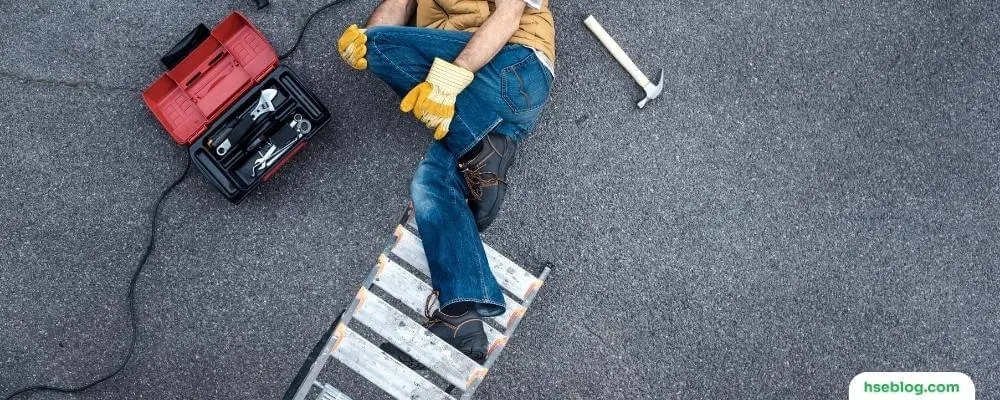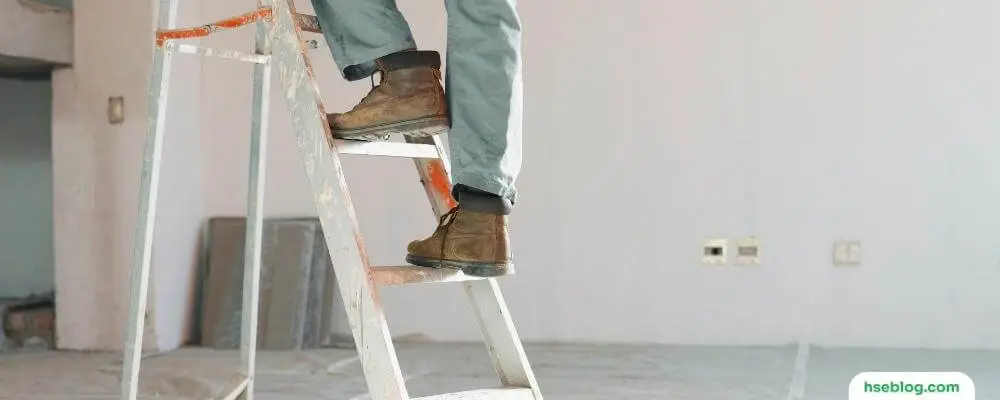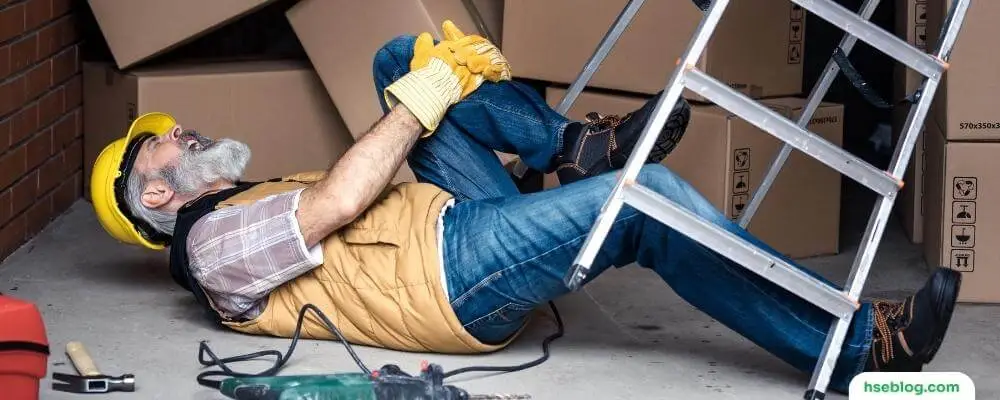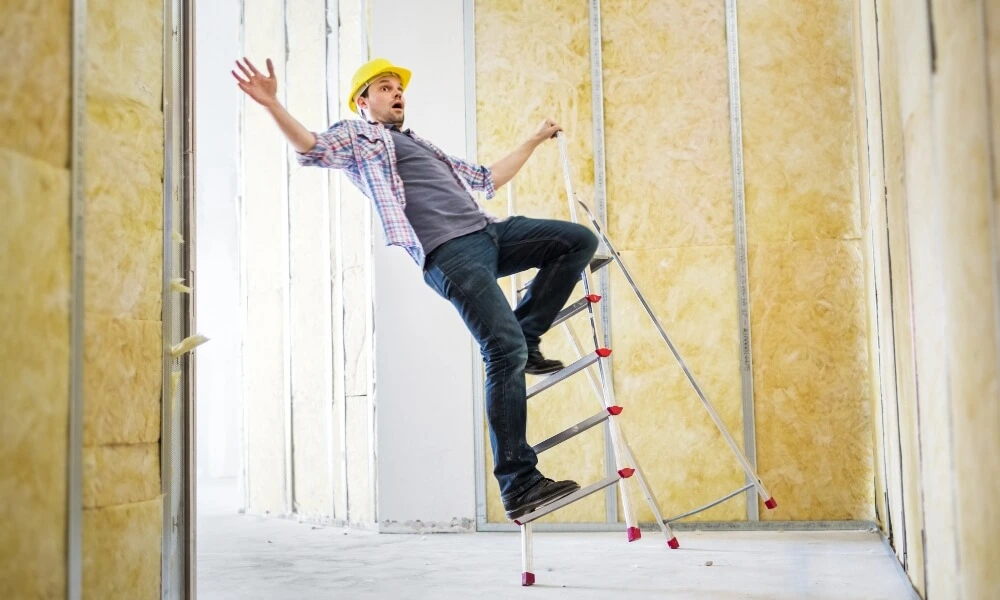Ladder accidents can be fatal or result in serious injuries. They can happen to anyone, from professional tradespeople to DIY enthusiasts. According to the National Safety Council, ladder accidents account for over 300 deaths and 165,000 nonfatal injuries annually in the United States alone. While ladder accidents are preventable, many people do not take the necessary precautions to ensure their safety while using ladders.
This blog will discuss the ten most common reasons for ladder accidents and how to avoid them. Whether you are a professional contractor or occasionally use a ladder for home repairs, these tips can help you stay safe and prevent accidents. We will cover everything from choosing the right ladder for the job to proper ladder setup and usage. Following these guidelines can significantly reduce the risk of ladder accidents and ensure a safe and successful project.
Common Reasons For Ladder Accidents
Ladder accidents can be caused by a variety of factors. Here are some of the most common reasons for ladder accidents:
1. Improper Ladder Selection
Improper ladder selection is one of the most common reasons for ladder accidents. Using the wrong type of ladder for a particular job can increase the risk of accidents, as can using a damaged or broken ladder. Some factors to consider when selecting a ladder include the ladder’s weight capacity, height, and material.
For example, if workers need to reach a roof, they may be tempted to use a small stepladder, which can be easily transported and set up. However, a stepladder may not be tall enough to safely reach the roof, and attempting to use it this way could lead to a fall. In this case, an extension ladder may be a better choice.
Similarly, using a ladder made from the wrong material can also increase the risk of accidents. For example, an aluminum ladder should not be used near electrical wires, as aluminum is a conductor of electricity. In this case, a fiberglass ladder would be a safer choice.
To prevent ladder accidents related to improper ladder selection, it is important to carefully consider the job requirements and select a ladder appropriate for the task. This may involve consulting ladder safety guidelines or seeking advice from a supervisor or safety professional. Additionally, workers should inspect their ladders regularly to ensure they are in good working condition and replace any damaged or broken ladders.

2. Incorrect Ladder Setup
Improper ladder setup is another common cause of ladder accidents. A ladder that is not set up correctly can easily tip over, causing injury to the person using the ladder. There are several factors to consider when setting up a ladder safely.
- Firstly, the ladder should be placed on a stable, level surface. If the ground is uneven, the ladder should be placed on a solid base or leveled using ladder levelers. The ladder’s feet should be firmly planted on the ground, and the ladder should not wobble or shift when weight is applied.
- Secondly, the ladder should be set up at the proper angle. The American Ladder Institute recommends placing the ladder so that the base is one-fourth of the ladder’s working length away from the wall or other vertical surface. For example, if the ladder is 16 feet long, the base should be 4 feet from the wall.
- Thirdly, the ladder should be secured to the vertical surface to prevent slipping. This can be done using ladder hooks, ties, or other securing mechanisms. The ladder should also be secured at the top to prevent it from sliding down or tipping over.
Workers should also be aware of the weight capacity of their ladder and avoid overloading it. The ladder should support the worker’s weight and any tools or materials.
To prevent ladder accidents related to improper setup, it is important to follow ladder safety guidelines and to properly train workers on ladder setup techniques. Ladder users should also inspect their ladders before use to ensure they are in good working condition and report any defects or damage to their supervisor.
3. Overreaching
Overreaching is another common cause of ladder accidents. When a worker tries to reach too far from the ladder or leans to one side, the ladder can shift or topple over, causing the worker to fall.
To prevent overreaching, ladder users should position the ladder properly to reach their work area without stretching or leaning. If the ladder is incorrectly positioned, they should move it to a better location rather than trying to reach it too far.
Ladder users should also avoid standing on the top rungs or standing on the ladder’s side rails. The top three ladder rungs should not be used for climbing, and the side rails of a ladder should not be used as a makeshift platform. Keeping the ladder’s center of gravity within its base is also important. This means that the ladder user should avoid leaning too far to one side while on the ladder and should keep their weight centered between the side rails.
To prevent ladder accidents related to overreaching, workers should be properly trained in ladder safety techniques, including how to position the ladder, climb and descend the ladder safely, and use fall protection equipment when necessary. Workers should also avoid carrying heavy or bulky items while on the ladder, which can reduce their balance and increase the risk of falls.

4. Lack of proper training
Lack of proper training is another common cause of ladder accidents. Workers not properly trained in ladder safety techniques may be unaware of the risks associated with ladder use and make mistakes that lead to accidents.
Proper training should cover topics such as ladder selection, ladder setup, safely climbing and descending the ladder, and using fall protection equipment when necessary. Workers should also be trained in hazard recognition to identify potential hazards in their work environment and take appropriate steps to mitigate the risks.
Training should be provided to all workers who use ladders, including new hires and temporary workers. Training should be provided in a language and format that the worker can understand and should be tailored to the worker’s experience and job responsibilities. Workers should also receive regular refresher training to stay up-to-date with the latest ladder safety guidelines and techniques. Refresher training can be especially important for workers who do not use ladders regularly, as they may be more likely to forget important safety procedures.
To prevent ladder accidents related to a lack of proper training, employers should provide comprehensive ladder safety training to all workers who use ladders. Employers should also provide the necessary resources and equipment to ensure workers can use ladders safely and enforce safe work practices on the job site.
5. Rushing
Rushing is another common cause of ladder accidents. Workers who try to complete a job quickly may be more likely to take shortcuts or skip important safety procedures, leading to mistakes that can cause accidents.
To prevent ladder accidents related to rushing, workers should be encouraged to take their time and follow proper ladder safety procedures. Workers should also be given adequate time to complete their tasks so they do not feel pressured to rush.
Supervisors and managers should lead by example, prioritizing safety and following proper safety procedures. This can help create a safety culture on the job site, where workers feel empowered to speak up about safety concerns and take the time to do their work safely. Employers should also consider implementing safety incentives or rewards to encourage workers to prioritize safety over speed. This can include bonuses or recognition for workers who demonstrate exceptional safety practices or penalties for workers who repeatedly violate safety policies.
To prevent ladder accidents related to rushing, employers should provide the necessary resources and equipment to ensure workers can complete their tasks safely and efficiently. Employers should also provide regular safety training and reminders to reinforce the importance of safety on the job site.

6. Distractions
Distractions are another common cause of ladder accidents. When workers are distracted by their phones, other electronic devices, or conversations with coworkers, they may not pay full attention to their work and surroundings, leading to mistakes that can cause accidents.
To prevent ladder accidents related to distractions, workers should be encouraged to focus on their work and avoid distractions while using ladders. This can include turning off electronic devices, avoiding conversations with coworkers, and avoiding other distractions that can take their attention away from their work. Employers can also help prevent distractions by implementing policies restricting electronic devices on the job site or by providing designated break areas where workers can take breaks and use their devices without posing a risk to themselves or others.
Employers should also provide adequate supervision and oversight to prevent distraction-related ladder accidents to ensure that workers follow safety procedures and work safely. Employers should also provide regular safety training to reinforce the importance of focusing on the task and avoiding distractions while working on ladders.
Finally, workers should be encouraged to speak up if they feel distracted or unsafe while working on ladders. Workers should be trained to recognize potential hazards and report safety concerns to their supervisors so that corrective action can be taken to prevent accidents.
7. Footwear
Footwear is another common cause of ladder accidents. Wearing inappropriate footwear, such as sandals or flip-flops, can increase the risk of slips and falls from ladders.
To prevent footwear-related ladder accidents, workers should wear appropriate footwear that provides good traction and support. Shoes or boots with slip-resistant soles and sturdy construction are recommended, as they can help prevent slips and falls on ladders.
Workers should also avoid wearing loose or dangling clothing, which can become entangled in the ladder and cause a fall. Long hair should be tied back or covered to prevent getting caught on the ladder. Employers should provide guidance and training on appropriate footwear and clothing for ladder use to prevent ladder accidents related to footwear. Employers should also enforce dress code policies that require workers to wear appropriate footwear and clothing while on the job site.
Employers should also provide regular maintenance and inspection of ladders to ensure they are in good working condition and do not pose a hazard to workers. Ladders should be inspected for damage or wear regularly, and any defects should be repaired or replaced promptly.
By wearing appropriate footwear and clothing, workers can help prevent ladder accidents and ensure they work safely and effectively. Employers can also play a key role in preventing ladder accidents by providing the necessary resources and equipment to ensure workers can work safely and efficiently on ladders.

8. Poor Physical Condition
Poor physical condition is another common cause of ladder accidents. Workers who are tired, ill, or under the influence of drugs or alcohol are likelier to have accidents while using ladders.
Physical exhaustion can affect a worker’s balance and coordination, making climbing or working on a ladder more difficult. Illness can also affect a worker’s ability to focus and maintain balance on a ladder. Similarly, the use of drugs or alcohol can impair a worker’s judgment and coordination, making it much more difficult to use a ladder safely.
Workers should be encouraged to care for their physical health and well-being to prevent ladder accidents related to poor physical condition. This can include getting enough rest, eating a healthy diet, and avoiding drugs and alcohol while on the job. Employers should also provide adequate rest breaks and work schedules that allow workers to get enough rest and avoid exhaustion. Employers should also have clear policies regarding drug and alcohol use on the job site and enforce these policies consistently.
Employers should also provide training on ladder safety techniques and best practices to prevent ladder accidents related to poor physical condition. This can help workers stay aware of the risks associated with ladder use and take steps to prevent accidents from occurring. By taking care of their physical health and staying alert while using ladders, workers can help prevent accidents and injuries on the job site.
9. Poor Lighting
Poor lighting is another common cause of ladder accidents. Ladder accidents are more likely to occur in poorly lit areas, where workers cannot see the ladder or the ground clearly. This can lead to tripping hazards, missteps, or other accidents that can cause injury.
Employers should provide adequate lighting where workers use ladders to prevent ladder accidents related to poor lighting. This can include installing additional lighting fixtures, using portable work lights, or positioning ladders in areas where natural light is available.
Workers should also use caution when working in poorly lit areas and should be trained to recognize potential hazards and take steps to mitigate the risks. This can include using a flashlight or other lighting tool to improve visibility or using reflective clothing or markings to make themselves more visible to others.
To prevent ladder accidents related to poor lighting, workers should also inspect their ladders before use to ensure they are in good working condition and free from defects. Workers should also report any lighting issues to their supervisor so that corrective action can be taken to improve the lighting in the area.
By taking steps to improve lighting in areas where workers are using ladders and using caution and proper safety procedures in poorly lit areas, workers can help prevent ladder accidents and ensure that they work safely and effectively.

10. Weather Conditions
Weather conditions are another common cause of ladder accidents. Windy or rainy weather can make ladder use more hazardous, as the ladder can be blown off balance or slippery.
To prevent ladder accidents related to weather conditions, workers should monitor weather conditions before using a ladder and avoid using ladders in inclement weather. Workers should take extra precautions to ensure their safety if ladder use is necessary for bad weather.
For example, workers should use non-slip shoes or boots with good traction to prevent slipping on wet surfaces. Workers should also secure the ladder to the vertical surface to prevent it from being blown off balance by wind gusts. Workers should also use caution when climbing or working on a ladder in windy conditions and be prepared to quickly climb down or dismount the ladder if the conditions become too hazardous.
To prevent ladder accidents related to weather conditions, employers should provide training on ladder safety in various weather conditions. They should enforce policies that require workers to avoid ladder use in dangerous weather conditions. Employers should also provide equipment and resources to help workers work safely in bad weather, such as non-slip shoes or boots, ladder levelers, and securing devices.
By taking extra precautions and using proper safety procedures in bad weather conditions, workers can help prevent ladder accidents and ensure they work safely and effectively.
Conclusion
Unfortunately, ladder accidents are all too common and can have serious consequences. However, many of these accidents are preventable with proper safety measures and precautions. By identifying and addressing the most common causes of ladder accidents, we can work to reduce the number of injuries and fatalities that occur each year.
Always follow safety guidelines when using a ladder, including checking the ladder for damage, ensuring it is on a stable surface, and maintaining three points of contact at all times. With diligence and attention to safety, we can work to prevent ladder accidents and keep ourselves and others safe while working at heights.

